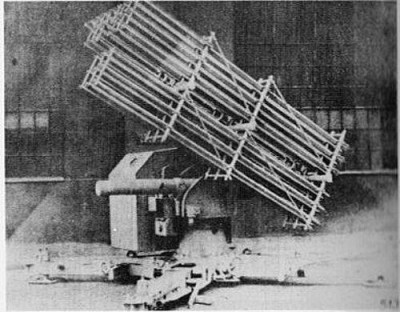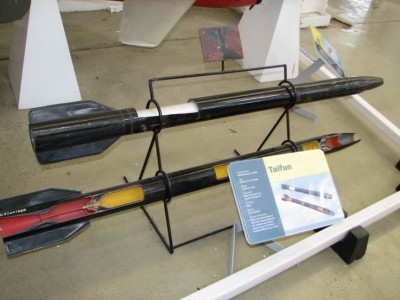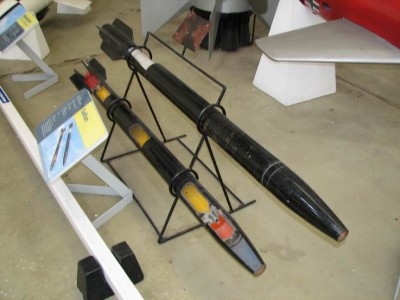This project was conceived in response to the acute need for anti-aircraft defence against Allied bombers flying at high altitudes. For this purpose, a competition was launched for an unguided missile with an altitude range of 10-12 km. The Taifun missile was developed in late 1944 at RVA Peenemünde. They were competed by the Tornado project by Rheinmetall Borsig/WASAG.
The Taifun rocket was 10 cm calibre, the load consisted of 0.7 kg of explosive. Stabilization of the missile was provided by four stabilizing wings with a span of 240 mm (220 mm?). Stability and dispersion were also aided by auxiliary rotation of the rocket, which was obtained by helical guidance and 1° aileron offset.
Taifun P
The propulsion was provided by a solid propellant engine.
Fuel: low-pressure tubular powder grain with grain size 84x29.5/1500 (11.6 kg)
max thrust: 20.6 kN
burn time: 1.5 - 1.7 s
missile weight: 24.8 kg
calibre: 100 mm
length: 2.1 m
span: 240 mm
max.1,150 (1,200) m/s (4,320 km/h)
range: 13 km
The firing was to be conducted electrically using power from a high-frequency generator.
Taifun F
Propulsion was provided by a liquid-fueled engine.
Several versions were developed.
The 8.32 kg propellant was a combination of Tonka 841/Salbei (vinylisobutyl ethyl ether and aniline + HNO3 with 10% H2SO4). The rocket engine was designed and manufactured by Elektromechanische Werke Karlshagen (codename from 1943 for Peenemünde). The motor had an operating time of 2.5 seconds and achieved a maximum thrust of 6.04 kN.
length: 1.93 m (1.89 m ?)
span: 240 mm
calibre: 100 mm
weight: 20.3 kg
maximum speed: 1000 m/s (1260 m/s ?) - 3600 km/h (4536 km/h ?)
maximum range: 15 (15.4) km
The rocket has been accepted for series production. Due to the more powerful liquid-fuel version, 50,000 Taifun F missiles were ordered, and it was expected that monthly production would ramp up to 1.5 million units of both missile designs from 5/1945. The price of one rocket was to be around 25.-RM.
The firing was to be carried out from a salvo rocket launcher, which was being developed at the Škoda Plzeň company. It had 30 firing positions and was mounted on an anti-aircraft gun. Only tests were carried out, the missiles were not deployed in combat.
The production was to take place in Nordhausen, where the Soviet troops found components for about 700 pieces of missiles. In total, about 15 pieces were assembled and 5 missiles were tested.
Jiří Kroulík, Bedřich Růžička - Vojenské rakety (Military Missiles), Naše vojsko publishing house, Prague, 1985
The Taifun rocket was 10 cm calibre, the load consisted of 0.7 kg of explosive. Stabilization of the missile was provided by four stabilizing wings with a span of 240 mm (220 mm?). Stability and dispersion were also aided by auxiliary rotation of the rocket, which was obtained by helical guidance and 1° aileron offset.
Taifun P
The propulsion was provided by a solid propellant engine.
Fuel: low-pressure tubular powder grain with grain size 84x29.5/1500 (11.6 kg)
max thrust: 20.6 kN
burn time: 1.5 - 1.7 s
missile weight: 24.8 kg
calibre: 100 mm
length: 2.1 m
span: 240 mm
max.1,150 (1,200) m/s (4,320 km/h)
range: 13 km
The firing was to be conducted electrically using power from a high-frequency generator.
Taifun F
Propulsion was provided by a liquid-fueled engine.
Several versions were developed.
The 8.32 kg propellant was a combination of Tonka 841/Salbei (vinylisobutyl ethyl ether and aniline + HNO3 with 10% H2SO4). The rocket engine was designed and manufactured by Elektromechanische Werke Karlshagen (codename from 1943 for Peenemünde). The motor had an operating time of 2.5 seconds and achieved a maximum thrust of 6.04 kN.
length: 1.93 m (1.89 m ?)
span: 240 mm
calibre: 100 mm
weight: 20.3 kg
maximum speed: 1000 m/s (1260 m/s ?) - 3600 km/h (4536 km/h ?)
maximum range: 15 (15.4) km
The rocket has been accepted for series production. Due to the more powerful liquid-fuel version, 50,000 Taifun F missiles were ordered, and it was expected that monthly production would ramp up to 1.5 million units of both missile designs from 5/1945. The price of one rocket was to be around 25.-RM.
The firing was to be carried out from a salvo rocket launcher, which was being developed at the Škoda Plzeň company. It had 30 firing positions and was mounted on an anti-aircraft gun. Only tests were carried out, the missiles were not deployed in combat.
The production was to take place in Nordhausen, where the Soviet troops found components for about 700 pieces of missiles. In total, about 15 pieces were assembled and 5 missiles were tested.
Jiří Kroulík, Bedřich Růžička - Vojenské rakety (Military Missiles), Naše vojsko publishing house, Prague, 1985
www.facebook.com
| Period | - |
| Type | - |
| Camouflage | - |
| Country | - |
| Production No. | - |
| Poznávací značka / evidenční číslo | - |
| Tactical marking | - |
| Name | - |
| Unit | - |
| Date (DD.MM.RRRR) | DD.MM.RRRR |
| Author | - |
| Print size / 300 DPI | - |
| Published with authors permit | - |
| Author Website | - |
| Period | - |
| Type | - |
| Camouflage | - |
| Country | - |
| Production No. | - |
| Poznávací značka / evidenční číslo | - |
| Tactical marking | - |
| Name | - |
| Unit | - |
| Date (DD.MM.RRRR) | DD.MM.RRRR |
| Author | - |
| Print size / 300 DPI | - |
| Published with authors permit | - |
| Author Website | - |



